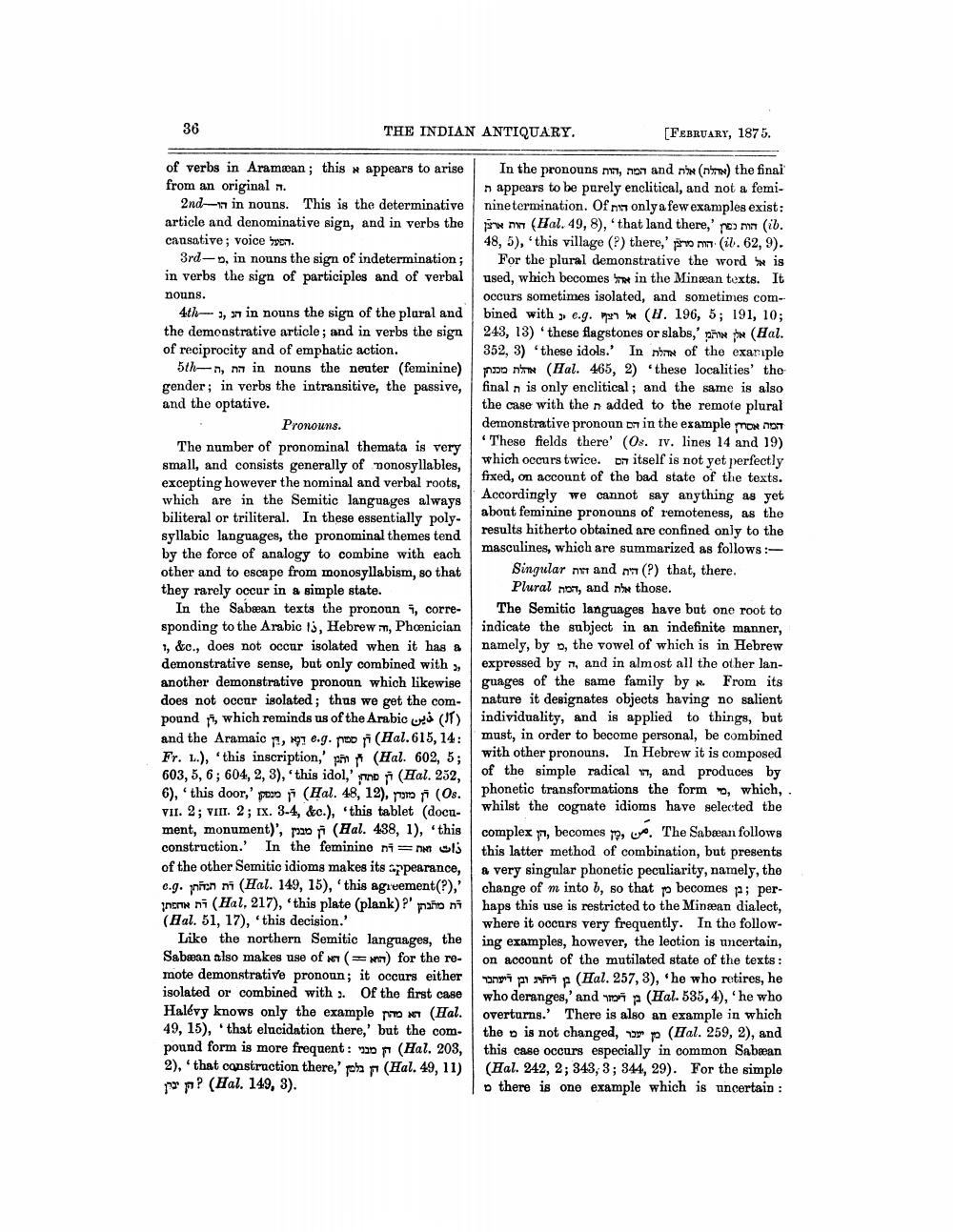________________
36
THE INDIAN ANTIQUARY.
[FEBRUARY, 1875.
the finni (אהלת) אלת and המת ,הות In the pronouns |
of verbs in Aramwan; this w appears to arise from an original m.
2nd-nin nouns. This is the determinative article and denominative sign, and in verbs the causative; voice on.
3rd-, in nouns the sign of indetermination ; in verbs the sign of participles and of verbal nouns.
4th-3, 31 in nouns the sign of the ploral and the demonstrative article; and in verbs the sign of reciprocity and of emphatic action.
5th-n, na in nouns the neuter (feminine) gender; in verbs the intransitive, the passive, and the optative.
Pronouns. The number of pronominal themata is very small, and consists generally of ponosyllables, excepting however the nominal and verbal roots, which are in the Semitic languages always biliteral or triliteral. In these essentially polysyllabic languages, the pronominal themes tend by the force of analogy to combine with each other and to escape from monosyllabism, so that they rarely occur in a simple state.
In the Sabæan texts the pronoun 1, corresponding to the Arabic Is, Hebrew m, Phoenician 1, &o., does not occur isolated when it has a demonstrative sense, but only combined with another demonstrative pronoun which likewise does not occur isolated; thus we get the com
appears to be purely enclitical, and not a femininetermination. Of not only a few examples exist:
(Hal. 49, 8), 'that land there,' po ma (ib. 48, 5), 'this village (?) there,' prom (ib. 62, 9).
For the plural demonstrative the word "w is used, which becomes in the Minnan texts. It occurs sometimes isolated, and sometimes combined with ,, e.g. r b (H. 196, 5; 191, 10; 243, 13) these flagstones or slabs,' pine poe (Hal. 352, 3) these idols.' In non of the exarıple poona (Hal. 465, 2) these localities' the final n is only enclitical; and the same is also the case with then added to the remote plural demonstrative pronoun on in the example prow DT
These fields there' (Os. iv. lines 14 and 19) which occurs twice. on itself is not yet perfectly fixed, on account of the bad state of the texts. Accordingly we cannot say anything as yet abont feminine pronouns of remoteness, as the results hitherto obtained are confined only to the masculines, which are summarized as follows:
Singular net and nat (?) that, there.
Plural non, and we those. The Semitic languages have but one root to indicate the subject in an indefinite manner, namely, by o, the vowel of which is in Hebrew expressed by, and in almost all the other languages of the same family by N. From its nature it designates objects having no salient individuality, and is applied to things, but must, in order to become personal, be combined with other pronouns. In Hebrew it is composed of the simple radical , and produces by phonetic transformations the form , which, whilst the cognate idioms have selected the complex y, becomes me. The Sabonn follows this latter method of combination, but presents & very singular phonetic peculiarity, namely, the change of m into b, so that p becomes p; per. haps this use is restricted to the Minæan dialect, where it occurs very frequently. In tho following examples, however, the lection is uncertain, on account of the mutilated state of the texts : dopri p (Hal. 257, 3), he who retires, he who deranges,' and 1 p (Hal. 535, 4), 'he who overturns. There is also an example in which the is not changed, op (Hal. 259, 2), and this case occurs especially in common Sabran (Hal. 242, 2; 343, 3; 344, 29). For the simple
there is one example which is uncertain :
pound , which reminds us of the Arabic (۲) ذین
and the Aramaic , 97 e.g. noori (Hal.615, 14: Fr. L.), this inscription,' pin (Hal. 602, 5; 603, 5, 6; 604, 2, 3), this idol,'mo (Hal. 232, 6), 'this door,' por (Hal. 48, 12), yom (Os. VII. 2; VIII. 2; IX. 3-4, &c.), 'this tablet (document, monument)', por (Hal. 438, 1), this construction. In the feminino nin ots of the other Semitic idioms makes its appearance, c.g. non mi (Hal. 149, 15), 'this agreement(?), NON ni (Hal, 217), 'this plate (plank)?' pao ni (Hal. 51, 17), 'this decision.'
Like the northern Semitic languages, the Sabwan also makes use of ( N) for the remote demonstrative pronoun; it occurs either isolated or combined with. Of the first case Halévy knows only the example po nov (Hal. 49, 15), that elucidation there, but the compound form is more frequent: 90 (Hal. 203, 2), that construction there,' trobar (Hal. 49, 11) pp? (Hal. 149, 3).




